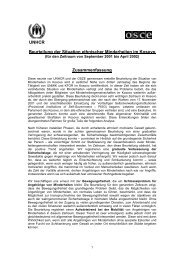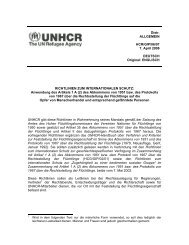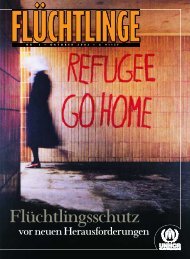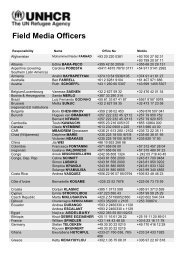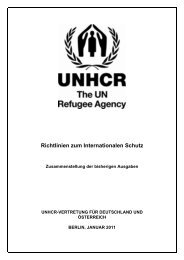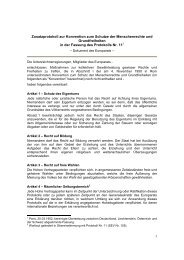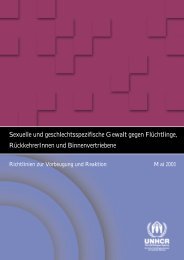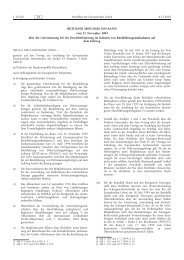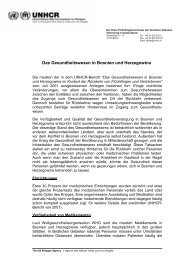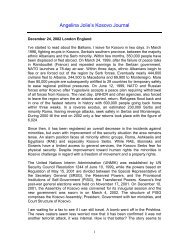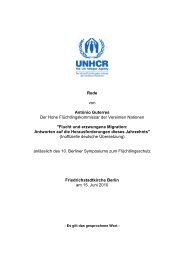EMBARGOED UNTIL MONDAY, 20 June 2011 0001 GMT ... - UNHCR
EMBARGOED UNTIL MONDAY, 20 June 2011 0001 GMT ... - UNHCR
EMBARGOED UNTIL MONDAY, 20 June 2011 0001 GMT ... - UNHCR
- No tags were found...
Create successful ePaper yourself
Turn your PDF publications into a flip-book with our unique Google optimized e-Paper software.
Fig. 5 Major refugee hosting countries | end-<strong>20</strong>10PakistanIslamic Rep. of Iran(a)Syrian Arab Rep.Germany(a)Jordan450,900Kenya402,900Chad347,900(b)China301,000(c)United States 264,600(c)United Kingdom 238,100crease of 4 per cent during the year. Thiswas due in part to the revision of the estimatednumber of Afghan refugees inPakistan from 1.7 to 1.9 million. (14)In Europe, the refugee population decreasedby 40,700 people (-2.5%) to 1.6 millionat end of <strong>20</strong>10. The drop was mainlya result of registration and verificationexercises conducted in the Balkans. InSerbia (and Kosovo: UNSCR 1244), thenumber of Bosnian and Croatian refugeesdecreased by nearly 13,000 peoplewhen figures were adjusted following aconsolidation of refugee databases, whichindicated that many who had achieveda durable solution either in Serbia (andProtracted refugeesituations<strong>UNHCR</strong> defines a protracted refugee situationas one in which 25,000 or more refugees of thesame nationality have been in exile for five yearsor longer in any given asylum country. Basedon this definition, it is estimated that some7.2 million refugees were in a protracted situationby end <strong>20</strong>10. This is the highest number since<strong>20</strong>01 with Iraqi refugees in Jordan and the SyrianArab Republic now being included.The 7.2 million refugees were living in 24 hostcountries accounting for a total of 29 protractedsituations globally. •594,3001,073,4001,005,5001,900,600a Government estimate.b The 300,000 Vietnamese refugees are well integrated and in practice receive protection from the Government of China.c <strong>UNHCR</strong> estimate.Kosovo: UNSCR 1244) or Croatia werestill registered as refugees in Serbia (andKosovo: UNSCR 1244).Likewise, refugee figures in Montenegrowere adjusted downwards from24,000 to 16,400 by the Government,following a comprehensive registrationexercise among refugees originatingfrom several Balkan countries.countries of asylumThe ten major refugee-hosting countriesin <strong>20</strong>10 were the same as those in<strong>20</strong>09 [see Figure 5], with all ten countrieshaving maintained their individualrankings of <strong>20</strong>09. Together these 10countries accounted for 62 per cent of allrefugees under <strong>UNHCR</strong>’s mandate.As in <strong>20</strong>09, Pakistan was the countrywith the largest number of refugees(1.9 million) globally, nearly all from Afghanistan,with an increase of 160,000people in the total population of thecountry. The Islamic Republic of Iranhosted slightly over 1 million refugees,again almost all Afghans. Figures inthe Islamic Republic of Iran remainedvirtually unchanged compared to <strong>20</strong>09.According to Government estimates,the Syrian Arab Republic was host toone million Iraqi refugees, making it14 This is an estimated number of Afghan refugeesregistered with the Government of Pakistan, and is subjectto change after completion of the verification exerciseongoing at the time of reporting.15 Government estimate.the third largest refugee-hosting country,despite a downward revision of5 per cent (-49,000 people) based onthe assumption that a number of Iraqishad departed the country.Germany and Jordan (15) reported594,300 and 450,900 refugees, respectively,at year end. In both countries,figures remained virtually unchangedcompared to <strong>20</strong>09.Kenya was the sixth largest hostingcountry at the end of <strong>20</strong>10, with almost403,000 refugees. The overall figureincreased by 44,000 people during theyear (+12%), mainly as a result of new arrivalsfrom Somalia. In <strong>20</strong>09 and <strong>20</strong>10,Kenya witnessed the arrival of over150,000 Somali refugees, stretching capacityin the Dadaab and Kakuma refugeecamps to a maximum.In Chad, the refugee population increasedto 347,900 by the end of <strong>20</strong>10(+3%) due to new arrivals from the CentralAfrican Republic and Sudan.In <strong>20</strong>08, Ethiopia was host to 83,600refugees, making it the 27 th largest refugeehosting country in the world at thattime, and the lowest level for Ethiopiain almost three decades. Since <strong>20</strong>08however, refugee figures have nearlydoubled with the arrival of tens of thousandsof Eritrean and Somali refugees.By the end of <strong>20</strong>10, the refugee populationhad grown to 154,300 makingEthiopia host to the 19 th largest refugeepopulation globally.countries of originWith more than three million refugeesin 75 countries, Afghanistan remainedthe leading country of origin of refugeesin <strong>20</strong>10. On average, three out often refugees in the world were fromAfghanistan, with 96 per cent of themlocated in Pakistan and the IslamicRepublic of Iran. Iraqis were the secondlargest group, with an estimated1.7 million having sought refuge mainlyin neighbouring countries. Afghan andIraqi refugees accounted for almost half(45%) of all refugees under <strong>UNHCR</strong>’sresponsibility worldwide. [see Map 2]Somalis constituted the thirdlargest refugee group under <strong>UNHCR</strong>’sresponsibility, with 770,<strong>20</strong>0 persons atthe end of <strong>20</strong>10 and twice as many asin <strong>20</strong>05. Compared to <strong>20</strong>09, the Somalirefugee population grew by almost14 <strong>UNHCR</strong> Global Trends <strong>20</strong>10




